And really, are you surprised it’s still popular? African drumming music is not just a joy to listen to, it seems to plug directly into your spinal cord via your gut and makes you want to move. You may not be surprised to know that African drumming was originally used as a way of communication, as well as playing an integral role in African culture. It could represent an entire spectrum of human emotion, which made it suitable to be part of each ceremony and celebration.
The music was so integral, in fact, that early slavers recognised the power of African drumming music, both as creating symbols and as a means of communication, and forbade the use or possession of drums in slave camps. Thanks to the strong spirits and wisdom of the African people, this form of expression continued—they simply resorted to tapping out a rhythm on their chest, arms, thighs, and whatever else was available to keep the music alive.
The diversity of cadence and sound that has grown from African drumming music is matched only by the variety of the African percussion instruments that have made their way around the globe.
Djembe Rhythms & Drumming
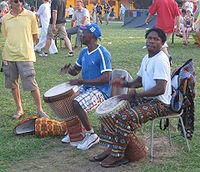 Incredibly versatile, the djembe drum is one of the most well-known African percussion instruments. A skilled djembefola (djembe master) can provide such a range of djembe beats on one drum as to keep an entire room of dancers busy.
Incredibly versatile, the djembe drum is one of the most well-known African percussion instruments. A skilled djembefola (djembe master) can provide such a range of djembe beats on one drum as to keep an entire room of dancers busy.Djembe techniques are quite an art form on their own and a djembe player typically spends several years learning from a djembe master before becoming a djembefola themself.
Kpanlogo Drums
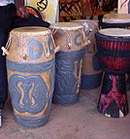 Communly used as a ceremonial drum, the kpanlogo drum originates from the Greater Accra Region in West Africa. Kpanlogo rhythms were frequently used as a way to communicate between tribes and family groups because of the drum’s brilliant ability to create sounds that carry over long distances.
Communly used as a ceremonial drum, the kpanlogo drum originates from the Greater Accra Region in West Africa. Kpanlogo rhythms were frequently used as a way to communicate between tribes and family groups because of the drum’s brilliant ability to create sounds that carry over long distances.African Talking Drums
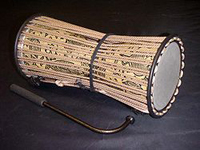 Crafted from wood and rawhide, African Talking Drums are shaped like an hourglass with the rawhide stretched across both ends, creating two surfaces for drumming. These particular drums are most often played with a stick on one side and with the hand and fingers on the other. As the name suggests, they were also commonly used in communication.
Crafted from wood and rawhide, African Talking Drums are shaped like an hourglass with the rawhide stretched across both ends, creating two surfaces for drumming. These particular drums are most often played with a stick on one side and with the hand and fingers on the other. As the name suggests, they were also commonly used in communication.African Bongos
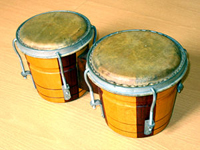 Now here’s a drum that we’ve all heard of! Bongos, which are widely used in Cuban drum music and dance music throughout the world, are thought to have become well-known in Cuba as a result of the slave trade. It is usually fairly squat and generates a beat with a fairly high pitch.
Now here’s a drum that we’ve all heard of! Bongos, which are widely used in Cuban drum music and dance music throughout the world, are thought to have become well-known in Cuba as a result of the slave trade. It is usually fairly squat and generates a beat with a fairly high pitch.Dun Dun Drums
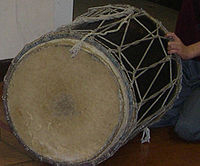 Dun Dun drums, which are also identified as dundun drums and dun dun duuun, are thought to originate from the Malinke area of Mali. The three sizes of Dun Duns, from smallest to largest, are Kenkeni, Sangban and Dununba. They can be played apart from each other but are also played strapped together in groups of two or three.
Dun Dun drums, which are also identified as dundun drums and dun dun duuun, are thought to originate from the Malinke area of Mali. The three sizes of Dun Duns, from smallest to largest, are Kenkeni, Sangban and Dununba. They can be played apart from each other but are also played strapped together in groups of two or three.Ngoma Drums
These drums have a meaningful connection to certain groups of people in Uganda as ceremonial instruments. The word ‘ngoma’ is Swahili for ‘drums’, which makes describing this particular drum a little difficult. The name is most often used for an group of 6 or 7 drums of various sizes strapped together and played as a group.
Itotele
Another drum popular in Cuba is the mid-sized, goblet-shaped one called the Itotele. Sometimes a waxy substance is used to coat the drumhead to create a duller sound.
As can be seen from the variety of African percussion instruments that we’ve mentioned – and the dozens more that we haven’t talked about – African drum music is varied and is a fantastic style of artistic expression. It’s a pleasure to create, and a pleasure to listen to!

